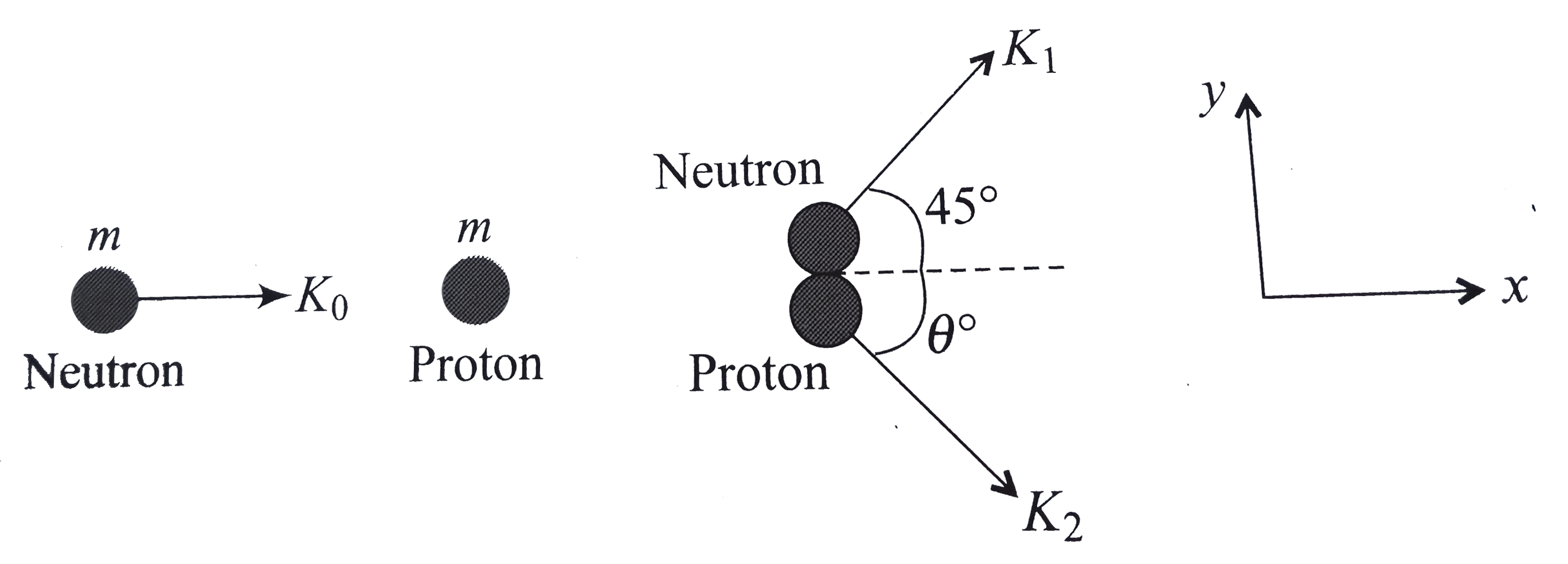A neutron with an energy of 4.6MeV collides elastically with proton and is retarded. Assuming that upon each collision the neutron is deflected by 45∘, find the number of collisions which will reduce its energy to 0.23eV.
Mass of neutron-mass of proton=m

From conseervation of momentum in y-direction,
√2mK1sin45∘=√2mK2sinθ …(i)
In x-direction
√2mK0=√2mK1cos45∘+√2mK2cosθ …(ii)
Squarring and adding Eqs, (i) and (ii), we have
K2=K1+K0−√2K0K1 ...(iii)
From conseervation of energy ,
K2=K0+K1 [as collision is elastic] ...(iv)
Solving Eqs, (iii) and (iv), we get
K1=K02
i.e. after each collision energy remain half. Therefore , after n collision ,
Kn=K0(12)n
∴0.23=(4.6×106)(12)n 2n=4.6×1060.23
Taking log and solving, we get
n=24
Topper's Solved these Questions
- BOOK - CENGAGE PHYSICSCHAPTER - ATOMIC PHYSICSEXERCISE - Solved Examples23videos
ATOMIC PHYSICS
- BOOK - CENGAGE PHYSICSCHAPTER - ATOMIC PHYSICSEXERCISE - Exercise 4.115videos
ATOMIC PHYSICS
- BOOK - CENGAGE PHYSICSCHAPTER - ALTERNATING CURRENTEXERCISE - QUESTION BANK65videos
ALTERNATING CURRENT
- BOOK - CENGAGE PHYSICSCHAPTER - ATOMSEXERCISE - QUESTION BANK40videos
ATOMS
Similar Questions
How many head-on, eleastic coillisions must a neutron have with deuterium nucleus to reduce its energy from 1MeV to 0.025eV.
View SolutionA neutron collides elastically with an initially stationary deuteron. Find the fraction of the kinetic energy lost by the neutron
(a)in a head-on collision
(b) in scatterting at right angles.View Solution
Knowledge Check
- Question 1 - Select One
An electron with kinetic energy =E eV collides with a hydrogen atom in the ground state. The collision will be elastic
Afor all values of EBfor E<10.2eVCfor E<13.6eVDonly for E<3.4eV - Question 2 - Select One
A neutron makes is a head - on elastic collision with a stationary deuteron The fraction energy loss of the neutron in the collision is
A16/81B8/9C8/27D2/3 - Question 3 - Select One
An electron of the kinetic energy 10eV collides with a hydrogen atom in 1st excited state. Assuming loss of kinetic energy in the collision be to quantized which of the following statements is correct?
AThe collision may be perfectly inelasticBThe collision may be inelasticCThe collision may be elasticDThe collision must be inelastic
A neutron collides elastically with an initially stationary deuteron. Find the fraction of the kinetic energy lost by the neutron (a) in a head-on collision , (b) in scattering at right angles.
View SolutionA neutron of kinetic energy 65eV collides inelastically with a single ionized helium atom at rest.It is scattered at an angle of 90∘ with respect of its original direction.
(i) Find the allowed values of the energy of the neutron & that of the atom after collision.
(ii) If the atom gets de-excited subsequently by emitting radiation, find the frequencies of the emitted radiation.
(Given : Mass of the atom =4× ( mass of neutron ) , ionization energy of H atom =13.6eV)View SolutionA neutron moving at a speed v undergoes a head-on elastic collision with a nucleus of mass number A at rest. The ratio of the kinetic energies of the neutron after and before collision is :
View SolutionA neutron with a kinetic energy of 6.0 eV collides with a stationary hydrogen atom in its ground state. Explain why the collision must be elastic-that is, why kinetic energy must be conserved. (Hint: Show that the hydrogen atom cannot be excited as a result of the collision.)
View SolutionOn an average, a neutron loses half of its energy per collision with a quesi-free proton. To reduce a 2MeV neutron to a thermal neutron having energy 0.04eV, the number of collisions requaired is nearly .
View Solution

